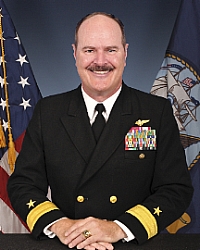Admiral “Hyfi” Harris on Training for the High End Fight
Prior to his becoming commander of the Nimitz Strike Group, we visited NAS Fallon and met with head of that command and discussed the way ahead for training for the high end fight.
This interview was first published August 9, 2017.
We first visited Fallon Naval Air Station in 2014 and produced a Special Report on the evolution of Naval Aviation anchored in part by that visit.
http://sldinfo.com/the-evolving-future-for-naval-aviation/
As the then head of the training center, Admiral Scott Conn, who will soon become head of N-98 or The Air Warfare Division of OPNAV, commented at the time:
Naval aviation is very interdependent on how we train aircrew and how we resource to those training requirements.
As competing readiness requirements pressurize the flight hour program, a bow wave is created by pushing training qualifications later on in one’s aviation career.
Naval aviation is looking at this issue hard, to ensure our future forward deployed leaders will have the requisite knowledge, skills and experience to in fact, lead.
We have returned to Fallon this summer and found the training command in the process of promoting significant change associated with preparation for the evolution of high tempo or high intensity combat operations.
The name of the command has changed in part to reflect the significant shift in direction for training for naval air warfare or really becoming combat development training, rather than training for platform proficiency as a core focus.
The target goal is to shape an integrated distributed force able to dominate at all levels throughout the spectrum of warfare.
Several changes have been already been put in place to facilitate this effort, and more are on the way.
One challenge though is the training word.
This term tends to conjure up learning skill sets on a platform and getting proficient on that platform and the conflict envelope within which that platform will confront peer competitors. The image of TOPGUN comes to mind in which it is aircraft versus aircraft in face offs to drive enhanced proficiency.
TOPGUN is part of NAWDC; not the definer of it.
Although platform proficiency is crucial, it is simply a building block in weaving capabilities for the integrated high-end fight and to do so requires significant change, some of which we saw in the period from our last visit to the latest one.
We had a chance during our visit to meet several times with and to interview the current head of the training command, Admiral “Hyfi” Harris.
This Fall the Admiral will join the Nimitz in operations in the Middle East where strike ops are being conducted currently against ISIS.
http://www.navy.mil/navydata/bios/bio.asp?bioID=993
Since we last visited the training command, the name has changed and that change reflects a broadening of the focus to both infusing the Navy with an evolving aviation approach and integrating the air wing with the broader challenges occurring within the fleet.
It is about preparing for the integrated high-end fight and the Naval Aviation Warfighting Development Center (NAWDC) captures that demand signal.
And with the arrival of software upgradeable aircraft, like Hawkeye and F-35, it will be increasingly important to put the evolving TTPs or Tactics Techniques and Procedures as part of the software code rewriting effort as well.
Prior to June 2015, NAWDC was known as Naval Strike and Air Warfare Center (NSAWC) which was the consolidation of three commands into a single command structure on July 11, 1996. NSAWC was comprised of the Naval Strike Warfare Center (STRIKE “U”) based at NAS Fallon since 1984, and two schools from NAS Miramar, the Navy Fighter Weapons School (TOPGUN) and the Carrier Airborne Early Warning Weapons School (TOPDOME).
NAWDC is the Navy’s center of excellence for air combat training and tactics development. NAWDC trains naval aviation in advanced Tactics, Techniques and Procedures (TTP) across assigned combat mission areas at the individual, unit, integrated and joint levels, ensuring alignment of the training continuum; to set and enforce combat proficiency standards; to develop, validate, standardize, publish and revise TTPs.
In addition, NAWDC provides subject matter expertise support to strike group commanders, numbered fleet commanders, Navy component commanders and combatant commanders; to lead training and warfighting effectiveness assessments and identify and mitigate gaps across all platforms and staffs for assigned mission areas as the supported WDC; collaborate with other WDCs to ensure cross-platform integration and alignment.
https://www.cnic.navy.mil/regions/cnrsw/installations/nas_fallon/about/nawdc.html
The Admiral emphasized the need to resource fully the training cycle by which he meant having the current operationally ready assets in the hands of the warfighters so that they could from the outset train effectively for deployment on the carrier.
He highlighted that there were two barriers, impeding the ability to get to an optimum training rhythm.
The first might be called readiness shortfalls.
“The Navy’s tiered readiness system, necessary in the current fiscal environment, has peaks and valleys in the training cycle.
“So you’ll come out of a maintenance phase and you’ll be at the low end of your training.
“We need to make sure that as soon as you go into the basic phase, you have every aircraft that you are authorized to have, and every aircraft has every system that it’s authorized.
“We want to be able to start the training right away, so that you can build reps and sets over time, versus the peak of coming here, getting reps and sets, and then slowing back down again.
“What we’ve found lately is that as squadrons are coming through, they’re about half a step, half a cycle behind.
“They’re not going into Basic Phase with their full kit.
“Therefore, when they go to their Advanced Readiness Program, they’re still getting up to speed.
“When they come to Fallon they’re still learning some of the things they should have learned in the Advanced Readiness Phase.
“And then when they go on to their Composite Training Unit Exercise (COMPTUEX) and marry up with the ship and the strike group, they’re still learning things that they should have been hard-wiring in Fallon.
“And we’re having to pass those gaps, if you will, onto the next piece of the training track.
“Readiness should be thought of as investing, the more you can do earlier, and allow that training to compound, the better of you are in the long run, particularly for the high end fight.”
The second challenge is having the most advanced equipment being used in the fleet available to NAWDC.
“If I had my way, we would have E-2D here at Fallon.
“We would have the most current Super Hornet.
“We would have F-35 on the line.
“We already have Growler, and our Growlers are operating with the same systems as the latest coming off of the line.
“And they would have all the systems necessary for our schoolhouse instructors to be out there on the cutting edge of developing tactics.
“And currently we’re doing it piecemeal.
“We are playing pickup sticks when we need to shape a more capable operational force with our TTP development here at NAWDC.”
And the enhanced integrated training and development is at the heart of preparing the fleet for higher tempo operations.
We discussed this development in two ways.
First, NAWDC is working very closely with the surface warfare training community and the Air Force in shaping a more integrated combat training perspective which needs to become more significant in shaping development as well.
With regard to the surface warfare community, the Admiral emphasized the following:
“We have surface warfare officers here at NAWDC.
“We work closely with the Surface Warfare training community as well in shaping a more integrative and integrated approach as well.”
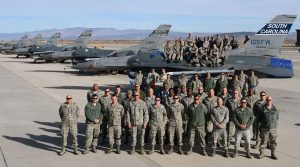 U.S. Air Force members from the 169th Fighter Wing and South Carolina Air National Guard are deployed to Naval Air Station Fallon, Nevada Fallon to support Naval Carrier Air Wing One with pre-deployment fighter jet training, integrating the F-16’s suppression of enemy air defenses (SEAD) capabilities with U.S. Navy fighter pilots. (U.S. Air National Guard photo by Tech. Sgt. Caycee Watson) September 2016
U.S. Air Force members from the 169th Fighter Wing and South Carolina Air National Guard are deployed to Naval Air Station Fallon, Nevada Fallon to support Naval Carrier Air Wing One with pre-deployment fighter jet training, integrating the F-16’s suppression of enemy air defenses (SEAD) capabilities with U.S. Navy fighter pilots. (U.S. Air National Guard photo by Tech. Sgt. Caycee Watson) September 2016
With regard to the USAF and integrative training, the Admiral focused on the Growler training with the USAF.
“Our HAVOC team works with the USAF Weapons School in the Weapon School Integration phase which runs about a month.
“If you want to think of it in the college realm, this is a 400-level class.
“And we’re seeing the Growler used differently by the Air Force than we would probably use it in the Navy.
“That cross-pollination has been extremely useful for both the services.”
Second, the F-35 is a very different type of combat aircraft and it would be good to see pairings of that aircraft with Advanced Hawkeye and the Growler to shape the evolution of information dominance operations, as a very clear outcome of working these advanced platforms together to deliver evolving combat capabilities.
“I would like to have advanced Hawkeyes, F-35s and Growlers all here so that we can work integrated TTPs to shape a more effective way ahead for the operational capability of the fleet.”
“I would like to get those type model series weapons and tactics instructors cross-pollinated even more, so that the classes and the courses are integrated more fully than they are now.
“We’ll have to find different ways to do that because of the Navy’s carrier cycle; we are not resourced to be able to do an air wing and do full Weapons and Tactics Instructor classes at the same time.
“We have to keep those separated. I’d like to move closer to the USAF model, but we don’t have that flexibility because of the carrier operational cycle.”
One way NAWDC will expand its work on integrated warfare is by being able to use new facilities being built right now that will integrate the platform simulators and allow for integrated training and operational thinking at NAWDC.
“We are building an integrated training facility.
“We’re going to have all of our simulators under one building, under one common security environment, so that we can do planning, briefing, execution, and debriefing all under the same security umbrella with the full team.
“The demand signal is that we all need to work together; and the new buildings are being built to meet that demand signal.”
These new facilities will allow for the growth of live virtual constructive training (LVC), although this LVC approach is in its infancy but will become more significant to combat development and training efforts over time.
Integrative and interactive training is a key element of shaping a more capable 21st century combat force.
One element leading to greater success in this effort is a more integrated air and surface warfare community.
As the Admiral put it: “The SWO boss, Admiral Rowden, has been pretty adamant about the benefits of their Warfighting Development Center, the Surface and Mine Warfighting Development Center.
“SMWDC has been, in my mind, going full bore at developing three different kinds of warfare instructors, WTIs.
“They have an ASW/ASUW, so anti-surface and anti-submarine warfare officer.
“They have an IAMD officer and they have an expeditionary warfare officer.
“Admiral Rowden talks about distributed lethality and they are getting there rapidly.
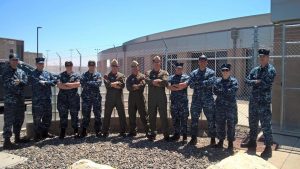 Warfare tactics instructors (WTI), from left to right, Lt. Cmdr. Mike Dwan, Lt Doug Wilkins, Lt. Lisa Schmidt, Lt Joseph Lewis, Lt Scott Margolis, Lt. Andrew Blanco, Lt Weston Floyd, LT Justin Bolly, Lt. Serg Samardzic, Lt. Rebecca O’Brien, and Lt. Cmdr. Derek Rader pause for a group photo at Naval Air Station (NAS) Fallon, in Nevada. The 11 integrated air and missile defense (IAMD) WTIs participated in a pilot integrated air defense course (IADC) — a joint effort led by the Naval Surface and Mine Warfighting Development Center (SMWDC) and Naval Aviation Warfighting Development Center (NAWDC). IADC will activate in late 2016 and train carrier air wings, carrier strike groups, and air and missile defense commanders in a simulated training environment at NAS Fallon. Several IAMD WTIs will teach and train the inaugural course alongside their aviation counterparts from Navy Weapons Fighter School (TOPGUN).
Warfare tactics instructors (WTI), from left to right, Lt. Cmdr. Mike Dwan, Lt Doug Wilkins, Lt. Lisa Schmidt, Lt Joseph Lewis, Lt Scott Margolis, Lt. Andrew Blanco, Lt Weston Floyd, LT Justin Bolly, Lt. Serg Samardzic, Lt. Rebecca O’Brien, and Lt. Cmdr. Derek Rader pause for a group photo at Naval Air Station (NAS) Fallon, in Nevada. The 11 integrated air and missile defense (IAMD) WTIs participated in a pilot integrated air defense course (IADC) — a joint effort led by the Naval Surface and Mine Warfighting Development Center (SMWDC) and Naval Aviation Warfighting Development Center (NAWDC). IADC will activate in late 2016 and train carrier air wings, carrier strike groups, and air and missile defense commanders in a simulated training environment at NAS Fallon. Several IAMD WTIs will teach and train the inaugural course alongside their aviation counterparts from Navy Weapons Fighter School (TOPGUN).
“We are watching young lieutenants share with their bosses in a training environment, specifically during IADC (Integrated Air Defense Course).
“This is probably not the way we want AEGIS set up, or how we want the ship to be thinking in an automated mode.
“We may not previously have wanted to go to that next automated step, but we have to because this threat is going to force us into that logic..
And you’re seeing those COs, who were hesitant at first, say, “Now after that run in that event, I get it. I have to think differently.”
A second element is building out training ranges in a key area of operations, namely the Pacific.
“We do need to continue, to work beyond Nellis, beyond Yuma, beyond Fallon, we’ve got to start looking at what could we do in Alaska, how can we make Alaska and the events that we do in Northern Edge, more robust?
“What kind of systems, what kind of sensors, whether it’s TCTS or the ability to go back and replay an event up at Alaska.
“Or look at Guam as a graduate-level training area, what could we do in Guam when you’ve got all those assets that are there from both the Air Force and the Navy.
“How much more could you do in and around Guam?
“What could you do in Australia, with an ally who is very forward-leaning in technology and integrating with the U.S. Navy and the U.S. Air Force, and the way they are integrating their armed forces together?
“Where can you take advantage of those opportunities?
“All while understanding that as you do that, you are practicing or playing in somebody else’s backyard, and they are watching what you’re doing.
“How do you do that, where you can be watched?
“And what do you have to reserve for places where you’re less likely to be watched?
A third key element is working cross platform integration to shape a more effective approach to information dominance.
“How do I use the capabilities in the F-35 to enhance what I get out of that fourth-gen platform?
“And, in ways that you didn’t think you were going to do it before.
“Not just by being a bigger, better brother that’s going to take care of you on the playground.
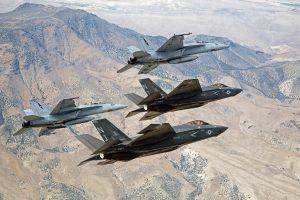 FALLON, Nev. (Sept. 3, 2015) F-35C Lightning IIs, attached to the Grim Reapers of Strike Fighter Squadron (VFA) 101, and an F/A-18E/F Super Hornets attached to the Naval Aviation Warfighter Development Center (NAWDC) fly over Naval Air Station Fallon’s (NASF) Range Training Complex. VFA 101, based out of Eglin Air Force Base, is conducting an F-35C cross-country visit to NASF. The purpose is to begin integration of F-35C with the Fallon Range Training Complex and work with NAWDC to refine tactics, techniques and procedures (TTP) of F-35C as it integrates into the carrier air wing. (U.S. Navy photo by Lt. Cmdr. Darin Russell/Released)
FALLON, Nev. (Sept. 3, 2015) F-35C Lightning IIs, attached to the Grim Reapers of Strike Fighter Squadron (VFA) 101, and an F/A-18E/F Super Hornets attached to the Naval Aviation Warfighter Development Center (NAWDC) fly over Naval Air Station Fallon’s (NASF) Range Training Complex. VFA 101, based out of Eglin Air Force Base, is conducting an F-35C cross-country visit to NASF. The purpose is to begin integration of F-35C with the Fallon Range Training Complex and work with NAWDC to refine tactics, techniques and procedures (TTP) of F-35C as it integrates into the carrier air wing. (U.S. Navy photo by Lt. Cmdr. Darin Russell/Released)
“But how do I pass information, what information needs to be passed, and when does it need to be passed?
“When do I have to be that white knight on the charger coming in to rescue you, to get you back on a timeline, and when can I just sit back and play maybe quarterback or coach and just suggest, look here, look there, do this, don’t worry about that threat.
“And the integration of how do I use that system and the capabilities in the F-35 with those that are in the Growler, where are they complementary?
“Where are they different, and mutually supportive?
“In the times that we have had the E-2D out here, how can I work all of those things together?”
And the evolution of LVC will play an important part in the combat development training process.
“LVC affords you that environment where you can do the very high-end warfare in an environment where you are not going to be observed. And you can integrate with your surface counterparts; you can integrate with your Air Force counterparts.
“That linkage is going to be phenomenal. Because now we’ll be able to go from F-22s, Air Force F-35, anything else they want to throw in the mix, all the way to AEGIS Baseline 9. And some of those can be live and some can be virtual.
“And we can go execute. I think that’s exciting.
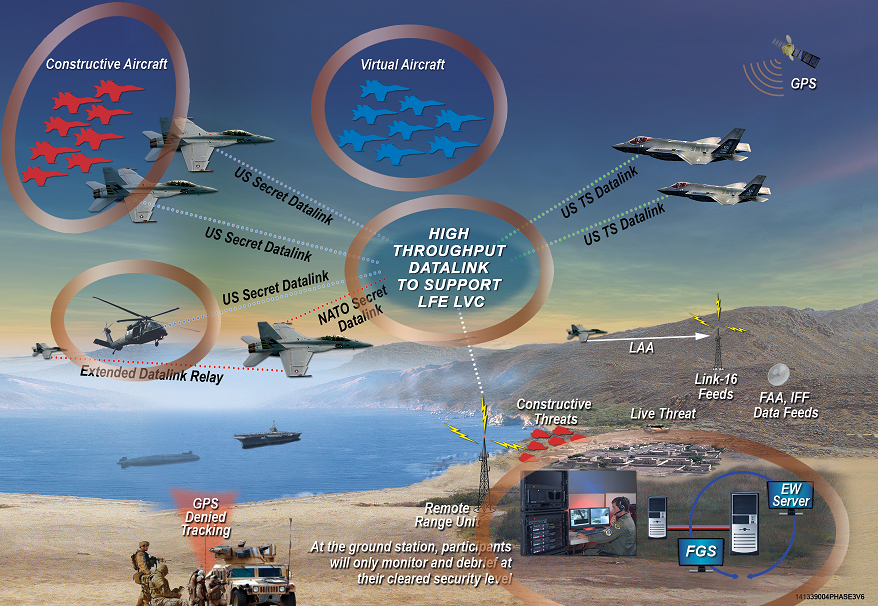 http://www.abdonline.com/news-analysis/defense/better-training-virtually/#.VGC_y1PF9OF
http://www.abdonline.com/news-analysis/defense/better-training-virtually/#.VGC_y1PF9OF
“When you can have a submarine launch a simulated TLAM that’s being tasked to them by a MOC somewhere else, that gets a real-time update from an actual F-35 flying on the range, that is seeing that the target that you thought was at point A has now moved to point B and you go back through the MOC to go through the firing unit to give that TLAM an updated target, that is powerful.”
Throughout the interview and in earlier conversations with the Admiral, the evolving man-machine relationship as a foundational element was discussed in several ways.
The CNO has highlighted the importance of enhancing the ability to leverage the man-machine relationships, notably with regard to preparing and executing high tempo and high intensity operations.
Nothing ever fully substitutes for time in the air. Consequently, the evolving ability to meld flight simulator training beyond the traditional emergency procedures or simulating mission flying is now being developed as a dynamic “man-machine” learning process.
The engagement process of content learning essentially is shaping how does a pilot and aircrews react to the speed-of-light dynamic flow of information in combat can be captured by both performance on the “range” and by the procedures followed in the cockpit.
Now those pilot and aircrew specific data points can be put into simulators, thus allowing real time repeat learning on how to be a better and better combat team.
The Admiral stressed it will be an exciting time as the new facilities come on line for both aircrews and commanders to specifically hone combat skills.
Clearly, the leveraging of the new platforms built around this relationship such as the F-35 and P-8 is important, as well as the capability to build out LVC and integrated simulation to train more effectively.
Above all, what the Navy is looking at are ways to shape new capabilities for learning and the ability to leverage machines to get better fidelity for learning.
The Admiral highlighted another aspect of this process when he discussed the need to enhance the ability to customize learning to repeat specific skill sets for warriors rather than having to repeat whole simulated courses.
“We are looking to improve simulated learning for targeted skillsets, and individualized learning over all. And one way you can do that is what they’re already seeing in the helicopter simulators, where the helicopter pilot is learning how to hover.
“And the simulator is assisting them as necessary to make the hovering more successful.
“As the pilot gets better, the learning software in the simulator backs out and allows the pilot to continue on their own.
“They get in the simulator the next day, the simulator knows who that person is, knows what they needed the day before, maybe backs that off a little bit to see if they’ve learned anything. And then brings it back up. So you have the simulator actually assisting with the learning.
“And they’re seeing that people are learning to do skills like hovering faster.”
The final subject we discussed is the close linkage between Fallon and the operational fleet in terms of developing TTPs on demand from the fleet as the fleet is engaged in operations.
One example was working TTPs for air combat strafing in Afghanistan as a carrier was about to engage in this task.
“ For example, we needed the ability in the mountains to do strafing at night because of the proximity of the threat and wanting to have a low threshold for civilian casualties met by using the gun on the Super Hornet and the Hornet.
“Very quickly NAWDC developed a methodology for night strafing, and it was developed, put right back out to the fleet, and executed within months.”
Another recent example was reviewing TTPs after the shootdown of a Syrian jet in the Middle East and working through the mission and sorting out any improvements in TTPs, which might need to be developed.
After an extensive review, none were deemed necessary to be made.
“The skillsets that we learned in the Advanced Readiness phase, and in Air Wing Fallon, and in COMPTUEX, were everything that we needed to be able to execute the mission we did in Syria.”
In short, NAWDC is a new type of combat training development command, which will be increasingly integrated with other warfighting development centers in building the warfighter for 21st century combat operations.
But it won’t happen without the right kind of investments, the right kind of shift in mindset and getting away from the platform centric mentality.
And its full impact will be seen when TTPs can be key drivers of development, software and shape modernization requirements going forward.
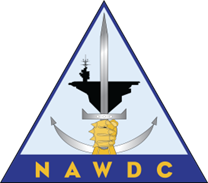
Appendix: The Structure of NAWDC
NAWDC’s individual mission requirements include:
N2: The Information Warfare Directorate at NAWDC is responsible for ensuring command leadership and personnel are provided the full capabilities of the Information Warfare Community (IWC) to support combat readiness and training of Carrier Air Wings and Strike Groups. The Directorate is comprised of four areas of focus: Air Wing Intelligence Training, the Maritime ISR (MISR) Cell, Targeting, and Command Information Services (CIS).
The Air Wing Intelligence Training Division is responsible for training CVW Intelligence Officers and Enlisted Intelligence Specialists in strike support operations. The MISR Cell is tasked with providing ISR integration into Carrier Air Wing training as well as qualifying MISR Package Commanders and Coordinators. The Targeting Division trains and certifies all CVW Targeteer personnel and provides distributed reach-back support for deployed units worldwide regarding target development. CIS provides cyber security and computer network operations for the entire NAWDC enterprise.
N3: NAWDC Operations department (N3) is responsible for the coordination, planning, synchronization, and scheduling for the operations of the command, its assigned aircraft, and airspace and range systems within the Fallon Range Training Complex (FRTC).
N4: NAWDC’s Maintenance Department is the heart of training for all the NAWDC schoolhouses. Maintenance’s focus is providing mission-ready fleet and adversary aircraft configured with required weapons and systems for all training evolutions. We support day to day training missions with the F-16 Viper, F-18 Hornet and Super Hornet, EA-18G Growler, E-2C Hawkeye and the MH-60S Seahawk; conducting scheduled and un-scheduled maintenance on 39 individual aircraft. These aircraft and weapon systems are the foundation for all other NAWDC Department’s training syllabi.
N5: Responsible for training Naval aviation in advanced Tactics, Techniques and Procedures (TTP) across assigned combat mission areas at the individual, unit, integrated and joint levels, ensuring alignment of the training continuum; to set and enforce combat proficiency standards; to develop, validate, standarize, publish and revise TTPs.
Also provides subject matter expertise support to strike group commanders, numbered fleet commanders, Navy component commanders and combatant commanders; to lead training and warfighting effectiveness assessments and identify and mitigate gaps across all platforms and staffs for assigned mission areas as the supported WDC; and collaborates with other WDCs to ensure cross-platform intergration and alignment.
NAWDC’s Joint NAWDC’s Joint Close-Air Support (JCAS) Division continues to answer the needs of current theater operations with increased production of Joint Terminal Attack Controllers Course (JTACC).NAWDC’s Joint NAWDC’s Joint Close-Air Support (JCAS) Division continues to answer the needs of current theater operations with increased production of Joint Terminal Attack Controllers Course (JTACC). NAWDC JCAS primarily trains Naval Special Warfare and Riverine Group personnel, but has this year also trained U.S. Army Special Operations, U.S. Marine Corps Air and Naval Gunfire Liaison Officers, international personnel, as well as U.S. Navy Fixed and Rotary Wing Forward-Air Controller (Airborne) personnel.
NAWDC’s JCAS branch is the U.S. Navy’s designated representative to the Coalition JCAS Executive Steering Committee, and is a recognized authority on kinetic air support to information warfare (IW), tactical precision targeting, and digitally aided CAS.
N6: Carrier Airborne Early Warning Weapons School (CAEWWS), also referred to as TOP DOME, is the E-2 weapon school and responsible for Airborne Tactical Command and Control advanced individual training via the Hawkeye Weapons and Tactics Instructors (HEWTIs) class. CAEWWS is also responsible for development of community Tactics, Technique and Procedures and provides inputs to the acquisition process in the form of requirements and priorities for research and development (R&D), procurement, and training systems.
CAEWWS works closely to support other Warfare Development Centers and Weapons Schools; such as the Surface and Mine Warfighting Development Center’s Integrated Air Defense Course (IADC) and Integrated Air and Missile Defense WTI Integration Course (IWIC). Other functions include support to advanced integrated fleet training by way of WTI augmentation to the N5/STRIKE Department for CVW integrated training detachments; also known as Air Wing Fallon Detachment and support of squadron activities.
N7: In the early stages of the Vietnam War, the tactical performance of Navy fighter aircraft against seemingly technologically inferior adversaries, the North Vietnamese MiG-17, MiG-19, and MiG-21, fell far short of expectations and caused significant concern among national leadership.
Based on an unacceptable ratio of combat losses, in 1967, ADM Tom Moorer, Chief of Naval Operations, commissioned an in-depth examination of the process by which air-to-air missile systems were acquired and employed. Among the multitude of findings within this report was the critical need for an advanced fighter weapons school, designed to train aircrew in all aspects of aerial combat including the capabilities and limitations of Navy aircraft and weapon systems, along with those of the expected threat.
In 1969, the United States Navy Fighter Weapons School (TOPGUN) was established to develop and implement a course of graduate-level instruction in aerial combat. Today, TOPGUN continues to provide advanced tactics training for FA-18A-F aircrew in the Navy and Marine Corps through the execution of the Strike Fighter Tactics Instructor (SFTI) Course. TOPGUN is the most demanding air combat syllabus found anywhere in the world. The SFTI Course ultimately produces graduate-level strike fighter tacticians, adversary instructors, and Air Intercept Controllers (AIC) who go on to fill the critical assignment of Training Officer in fleet units.
N8: Navy’s Rotary Wing Weapons School is composed of a staff of 25 pilots and aircrewmen who instruct the Seahawk Weapons and Tactics Instructor program; provide tactics instructors to fleet squadrons; maintain and develop the Navy’s helicopter tactics doctrine via the SEAWOLF Manual; instruct the Navy’s Mountain Flying School; provide high-altitude, mountainous flight experience for sea-going squadrons; and provide academic, ground, flight, and opposing-forces instruction for visiting aircrew during Air Wing Fallon detachments.
N9: The NAWDC Safety Department (N9) serves as the principle advisor to the Commander on all matters pertaining to safe command operations and is responsible for administering the following safety programs: aviation, ground, ergonomics, motor vehicles (personal, commercial), recreation, and on- and off-duty. Our goal is to eliminate preventable mishaps while maximizing operational readiness. We accomplish this by preserving lives, preventing injury, and protecting equipment and material.
N10: The US Navy’s Airborne Electronic Attack Weapons School, call sign “HAVOC”, stood up in 2011 to execute the NAWDC mission as it pertains to Electronic Warfare and the EA-18G Growler. HAVOC is comprised of highly qualified Growler Tactics Instructors, or GTIs, that form the “tactical engine” of the EA-18G community, developing the tactics that get the most out of EA-18G sensors and weapons. HAVOC’s mission is also to train Growler Aircrew and Intelligence Officers on those tactics during the Growler Tactics Instructor Course.
The Growler Tactics Instructor Course is a rigorous 12 week syllabus of academic, simulator, and live fly events that earn graduates the Growler Tactics Instructor designation – the highest level of EA-18G tactical qualification that is recognized across Naval Aviation. The Growler brings the most advanced tactical Electronic Warfare capabilities to operational commanders creating a tactical advantage for friendly air, land, and maritime forces by delaying, degrading, denying, or deceiving enemy kill chains.
N20: The Tomahawk Landing Attack Missile (TLAM) Department provides direct support to U.S. Fleet Forces Command (USFFC) in the development and standardization of tactics, techniques and procedures for the employment of the Tomahawk weapon system. In addition, TLAM provides training to the CVW, fleet, and joint commands on TLAM capabilities and strike integration
https://www.cnic.navy.mil/regions/cnrsw/installations/nas_fallon/about/nawdc.html

http://sldinfo.com/allied-pacific-exercises-and-training-shaping-a-deterrence-in-depth-strategy/

